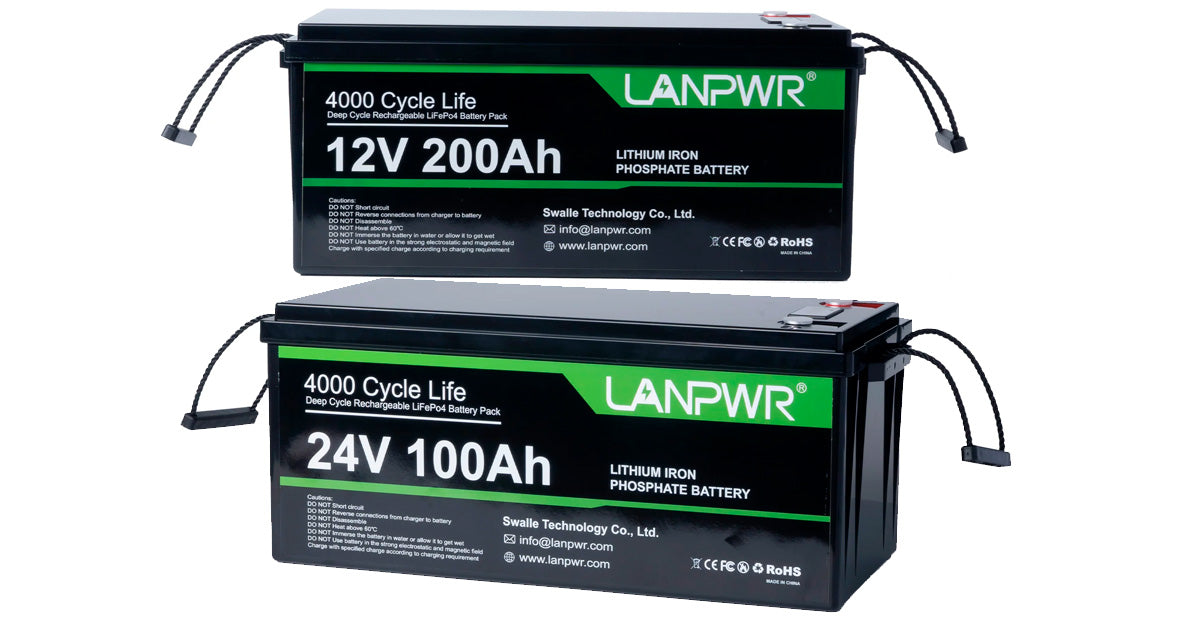The LiFePO4 batteries, a kind of lithium-ion battery, are a favorite because of their longevity and efficiency. It is important to understand the features of these batteries since they need to be used properly and given the environment that will enhance their lifespan and performance. This manual is designed to provide users with the know-how to correctly care for the batteries so that such elements always perform up to par.
The LiFePO4 Batteries are the ones that know the function of LiFePO4 Batteries.
Basic Properties
Due to their remarkable features, lithium-ion-phosphate batteries, LiFePO4, have occupied a portion of the market. They provide materials whose features, as opposed to lithium-ion ones, are enhanced safety, longevity, and resistance lines. Thus, LiFePO4 batteries are the best choice of batteries in those applications where reliability and durability are the most sought-after qualities. Their capability to deliver a high level of reaction in even stressful circumstances highlights the future of power technology.
Furthermore, LiFePO4 batteries are more eco-friendly, with chemicals that are difficult to make away. Thus, they can be used safely in several fields, ranging from electric vehicles to renewable energy systems. This safety feature, together with its long service life and low maintenance requirements, makes users feel safe and informs them that the total cost of ownership is much lower than that of other battery technologies.
Internal Chemical Reactions
The way a LiFePO4 battery is stored may be what helps determine all the internal chemical reactions it goes through. Insufficient charge regimes can promote the degradation of the battery, which may cause a rapid reduction in efficiency and power storage capacity. Through the chemistry of these batteries, the users can determine the storage conditions that will be best for them and, thus, avoid the negative effects. For instance, heat generation could lead to increased internal resistance and self-discharge. Thus, high-temperature conditions may contribute to severe self-discharge and irreversible capacity loss, while low temperatures can cause more resistance and reduce the available capacity.

As a result, storage conditions are just one tool for safeguarding the structural stability of the battery's electrodes and electrolytes. This care goes beyond the normal battery life and prolongs it by preventing premature aging and degradation, usually resulting from environmental extremes. Those users who possess an understanding of the chemistry taking place inside their batteries can then engage in preventive measures to increase their device's lifetime.
When addressing this topic, some considerations of the required conditions for making and storing the batteries of the type LiFePO4 are relevant.
Temperature Guidelines
The correct storage temperature is crucial for the LiFePO4 battery's health. In most cases, it is recommended that these batteries be kept in a dry and cool place where the heat and cold intensity are controlled to avoid extreme weather conditions. The ideal storage temperature range is 15-25°C (59-77°F). Keeping batteries within this range is crucial to mitigating the danger of capacity loss and preserving the electrolyte and electrode materials from deterioration.
In addition, due to the constraints of high temperatures, predominantly during summer, the battery's quality can seriously depreciate. Under such circumstances, the self-discharge rates may increase, and the chance of possible thermal events will be introduced, which would be incompatible with the battery's normal performance. On the other side of the coin, cold temperatures during winter could decrease the reaction rates within the battery, hence decreasing its available capacity and increasing the risk of damage during charging.
Charge Levels
Keeping an eye on the energy stored in LiFePO4 batteries when they are static is important because it directly affects their ability to hold charge at all times. To ensure the continuity of service when the battery is fully charged 20% of its capacity within 30 days. This level is enough to stop the battery from dropping to a dangerously low voltage and thus avoid irreparable damage to the battery's internal structure.
Cutting the charge level to around 15% for over a month or even close to three months could help reduce the battery parts' wear and tear. Undercharge levels prevent the occurrence of a paracone of reactions that normally occur at higher charge levels and, consequently, retain the battery’s (soil) capacity and longevity. The key thing for users to do is to keep an eye on these charges and adjust them according to the particular storage duration to prevent the batteries from degrading.
Extraction and Storing of Hydrogen as an Energy Vector and Problems of Recharging and Maintenance during Storage
Regular Maintenance
It should be noted that regular service of LiFePO4 batteries, like scheduled charging and discharging cycles, is a must for optimal performance in the long run. It is quite common for the battery to be charged every three months while the car is not in use. This cycling is unlike traditional cycling, where extreme states can occur, which may reduce the battery performance and capacity.
On the other hand, this process of charge-discharge cycles will also be useful to keep the cells in the battery area and their voltages in a range within its operation. This balance is what keeps the battery from getting under or overcharged, which in turn shortens its lifespan. To adhere batteries in such a way they function precisely, each layer is achieved by cycling them for such time when each of the cells works well and contributes to the battery performance and efficiency.

Investing in the Appropriate Tools
The key point for keeping LiFePO4 batteries in good condition is to select the right tools, especially the correct type of charger. The charger should be manufactured considering both the lithium material and the voltage limits of the batteries. This is important, as it ensures the battery can achieve its maximal charge without breaching the voltage limit. This helps retain the electricity in the batteries, prolonging their life cycles. Decent charging extends the battery life and also guarantees that it works at its top well when necessary.
The charger should have features that allow the user to have fine control over the charging process, including adjusting the current and voltage to match the specific characteristics of LiFePO4 batteries. This will also save the vehicle from overcharging, intensifying heat generation and might cause damage. On the other hand, total undercharging could be harmful because it remains at the partial discharge status, and the battery components may wear a bit faster.
Absolute particulars are given by making a mention of the storage duration.
Short-Term Storage Strategies
While storing LiFePO4 batteries for less than 30 days, it is important to carefully monitor the storage environment. The battery shall be stored in a ventilated space, which refrains from direct sun and heating devices. Keeping it cool and dry is highly recommended. This kind of conditioning contributes to sustaining the proper capacity and stability of the battery than in the case of other common conditions that degrade substantially the battery life span or its performance efficiency. Besides, the discharge rate during this period is relatively low, but the batteries can avoid any unexpected degradation by keeping an optimal charge level and environmental conditions.
To add more, the instant period of battery life requires possibility, too. Batteries that were loaded immediately after use without partial charge can show different behavior during subsequent storage than batteries that have been activated with the appropriate procedure before storage. Therefore, the battery is equally important during storage to ensure it is at the right charge level before storage.
Long-Term Storage Strategies
LiFePO4 battery storage can be a challenge, particularly for those who need to store LiFePO4 batteries for long periods of time beyond the 90-day mark. One variable that requires precise attention is the discharge rate during storage. The output rate is both time and environment-condition dependent: the longer the storage time, the deeper the discharging and a warmer environment can lead to an even deeper discharge. With long-term storage, the battery must be well-planned to not degrade it unnecessarily. It is recommended to run regular checks to monitor the charge level and mainly monitor if the battery remains within the safe operation limits.
Also, the use of, say, storing the battery in a slightly lower charge state and moderate temperature can be pretty appropriate for troubleshooting long-term effects. This procedure goes a long way in reducing the chemical reactions that see the battery die, thus retaining its capacity and being ready for use in the future. It is also required that a routine check for maintenance purposes every few months be put into place for the battery’s condition and, if required, make the necessary adjustments.
In Major Storage Errors to Steer Clear of
Environmental Hazards
Another common error committed when LiFePO4 batteries are being stored is that people do not consider the influence of environmental conditions. Batteries that are kept in various conditions other than being stored in heated or cold places, among others, pose great harm to them. The chores of the hottest weather over battery elements speed up the matter's decrement and raise the risks of security failures. By contrast, low temperatures can temporarily decrease battery efficiency and an enhanced danger of damage during charging if not appropriately handled.
Therefore, It is important to actively manage the storage environment because the opposite case can lead to such conditions. Applying strategies, including cooling storage units, can be very useful in the battle against environmental extremes, which might cause a lot of risks. These practices are implemented to ensure that the battery stays in good condition and keeps its performance up throughout storage.
Improper Charging Practices
Discharge error is another storage mismanagement issue that may occur when misusing the charger. Heeding manufacturer recommendations on charging and maintenance is much more than prolonging battery life. Violating these rules can result in incorrect charging, which will strain the battery, shorten its life, and increase the chances of it failing. The sticker charges are always recommended to keep the battery in perfect working condition so that it is ready to use when the moment comes.
Besides, improper use of a non-specified charger or overcharging can severely damage the most advanced LiFePO4 battery. Only battery chargers meant for these battery types should be used, and precise charging protocols should be followed to avoid overcharging or undercharging, which can harm the battery and its safety.
Frequently Asked Questions FAQs with respect to storage of LiFePO4 Batteries.
General Queries
This part becomes the toolkit for those looking for advice on optimizing their batteries LiFePO4. The advantages of this program are that it provides clear and concise answers to the most popular questions, thus helping users to understand how to handle their battery storage well. Consumers' apprehensions are wholly quelled once they receive answers to these recurrent questions that have been bothering them for some time. In this way, they can feel confident in prolonging the life of your battery and be assured that it will still perform at its optimum.
Technical Queries
To address those people with more technical questions, this part of the section goes deeper into the direction, such as the importance of storage conditions on the battery capability, the consequence that long-term storage can have on battery life, and the technical specifications helping you keep the proper performance. These responses, which are detailed, are made to give a complete understanding of the complex things in battery storage and maintenance, which is why users are empowered with the knowledge to make informed decisions about their battery care.
The storage of batteries of the LiFePO4 type is particularly important due to their years of reliability and economical operating comfort. By abiding by the procedure contained in his guide, users can make their battery use efficient and experience the benefits of reliable power sources. The initiatives mentioned above extend battery life and improve performance, making them a good option for anyone who wants reliable and long-lasting batteries.














Leave a comment
This site is protected by hCaptcha and the hCaptcha Privacy Policy and Terms of Service apply.